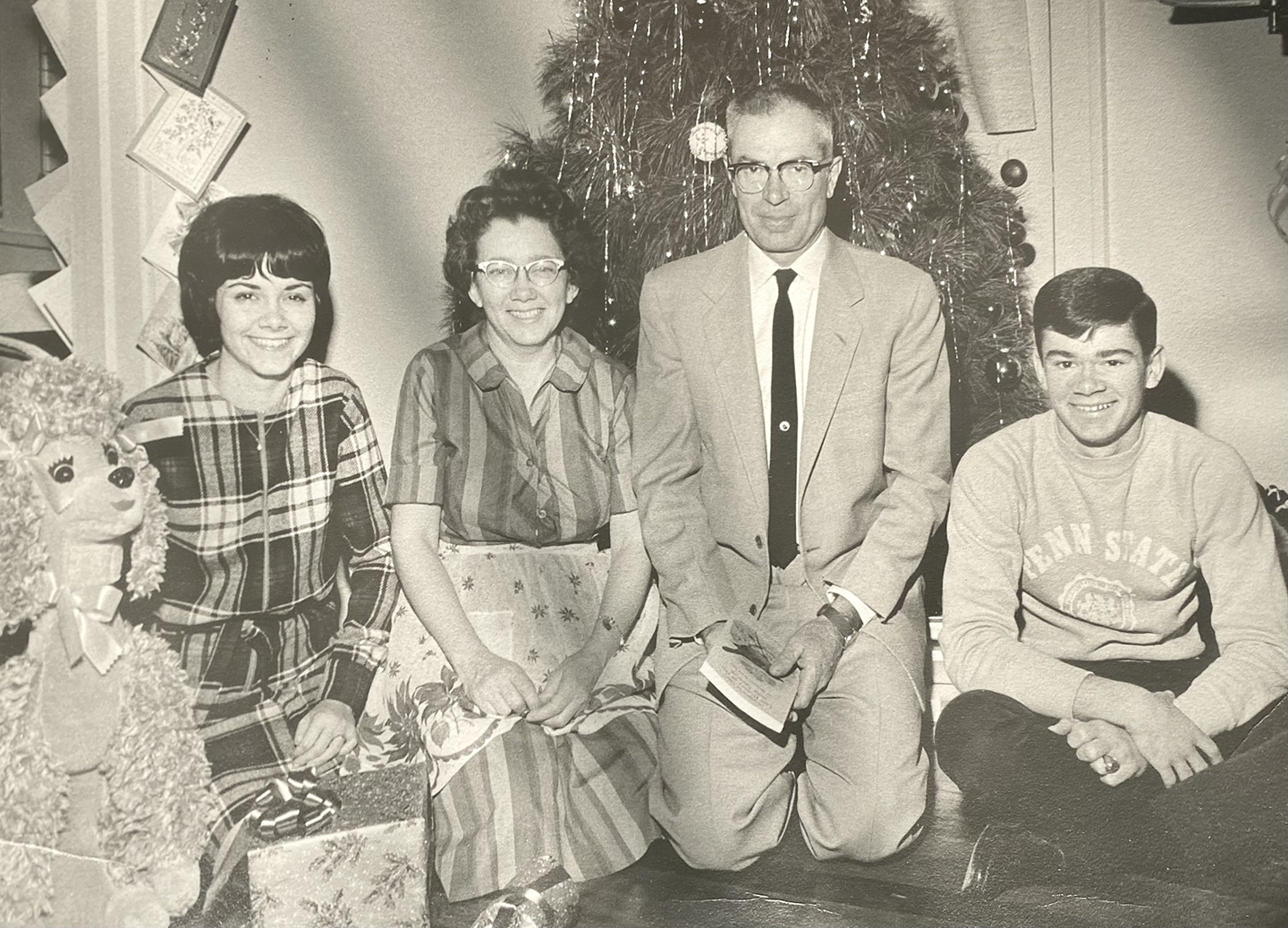This old photo is a chance to revisit Christmas 1964 with Ralph Bell and his family. They sit in the living room in front of their tinseled tree, surrounded by presents – daughter Joanie, wife Mary and son David. If you look close, you’ll see Ralph is – of course! – holding a bird book.
Most of us who knew Ralph remember a tall, spry older man who never looked or acted his age, with a genial smile and droll wit, leading bird walks around the county, or banding birds at Dolly Sods, WV during the fall migration season. Or riding in his 1948 Jeep, trucking across the fir-studded fields behind his barn to pick out the perfect Christmas tree.
Not too many people are still around to remember buying eggs from his family farm, or his graduation from Penn State University in 1938 with a BA in poultry husbandry. And now it’s only family and friends who remember him saying he started counting birds at age twelve and remembered listening to famed local ornithologist Warren Jacobs holding court in the barbershop in the Fort Jackson Hotel as a wide-eyed youngster. Ralph would spend the next 87 years keeping meticulous notes of weather and the birds he identified as he grew up to be a college educated farmer slash citizen scientist on a mission to pay attention to the natural world and work to protect it, one banded bird at a time.
The 2013 Audubon Christmas Bird Count was the last one for Ralph and I was there, riding shotgun as he and others drove the roads around Clarksville. December 28, 2013 was cold and snowless and birders were at a visual disadvantage. But for Ralph’s excellent ear, not to worry – he knew their every chirp.
“I’m color blind so I had to learn by sound,” he explained. At age 98, he was in his truck and in his groove, driving back roads at a bird watcher’s pace, windows down, doing citizen science for the world. There were birds to be seen and heard in thickets and back yards – nuthatches, junkets and crows, cardinals, blue jays, song sparrows and house sparrows, each with its own distinctive voice.
A pair of magpies appeared and Ralph was not surprised – he’d been counting magpies along this particular bend in the road for years. On other stretches he lamented the missing nesting boxes and feeders that used to be there, pointing out that bird populations hinge on access to food and shelter as humans displace their native habitat.
Audubon’s winter bird count depends on thousands of volunteers like Ralph, braving all kinds of weather as they scour the Northern Hemisphere between Dec. 15 and Jan. 5 to record the birds to be found within a 15-mile radius in 24 hours.
Greene County’s two circles take in the diversity between the county’s western hills and the eastern river habitats where an amazing variety of species are either hunkered down for winter or just passing through. This is a freeze-frame of where the birds are on a grand, planetary scale. Audubon has been taking these snapshots and analyzing the data ever since ornithologist Frank Chapman and 26 friends went out to count, rather than shoot birds for sport on Christmas Day in 1900. Ralph Bell, whose family farm straddles the postal line between Clarksville and Jefferson, was the originator of the county’s first circle around his farm in 1958.
 Going out by car or walking the field with someone who really knows their birds is a good way to get started at being a baby Ralph Bell. But learning to identify the birds that come to your feeder in your own backyard is a first step you can take yourself.
Going out by car or walking the field with someone who really knows their birds is a good way to get started at being a baby Ralph Bell. But learning to identify the birds that come to your feeder in your own backyard is a first step you can take yourself.
Go outside and listen. After hearing a bird call three or four times, it will be yours. Look, listen and learn.
My best memory of that Christmas Bird Count morning came when fellow birder Jamie Wolfe leaned from the back seat to explain that the new owner of one farm had taken down the row of bluebird boxes along her field because she said the birds were pooping on her car. “You should have told her to stop parking under trees,” Bell retorted without missing a beat.
Ralph was out the next spring mowing his fields and was there to greet but not walk with his fellow birders for a count on May 17, 2014.
Ralph’s obituary reports that on May 20 he told daughter Joanie he was tired, adding “I’ve had a wonderful life and loved every minute of it.” He died that day at age 99, leaving us this secret to living a long life: “Keep moving and never retire.”
Visit www.audubon.org to learn how you can become a citizen scientist, just like Ralph. Go online and Google Ralph K. Bell Bird Club to find the many links to both Ralph’s life and the clubs he was part of. You will meet the birders who knew Ralph and learned from him first hand and are more than willing to pass it on.
